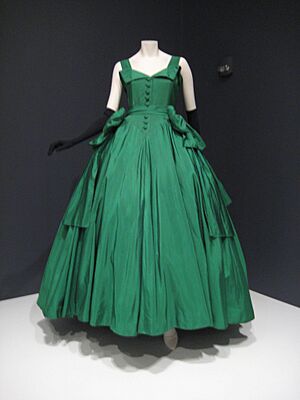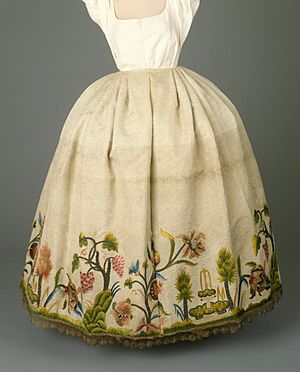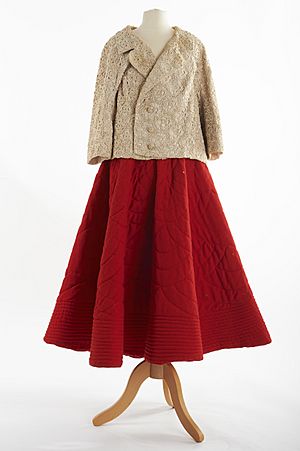Petticoat facts for kids
A petticoat is a special undergarment that women wear. It looks like a skirt or a skirt with a top part attached. You can think of it as a skirt worn underneath another skirt. Petticoats help keep you warm, but their main job is to make the outer skirt look fuller and more stylish.
Some petticoats are made stiff with starch, or they have ruffles, or they are made from stiff fabric. These types of petticoats can make a wider skirt stand out even more. The biggest and stiffest type of petticoat was called a crinoline. Crinolines had hoops inside, often made from whalebone, to create a very wide shape. People don't wear crinolines today, but sometimes petticoats are still worn with fancy ballgowns.

Contents
What is a Petticoat Called?
Sometimes, a petticoat might be called a waist slip or underskirt in the UK. In the US, it's often called a half slip. The word petticoat is usually saved for very full garments. A chemise is different because it hangs from the shoulders. In the UK, petticoat used to mean a full-length slip, but that's an older way of using the word.
A Brief History of Petticoats
Petticoats have a long and interesting history!
Early Petticoats
Back in the 14th century, both men and women wore undercoats called "petticotes." The word "petticoat" comes from old English words meaning "a small coat." At first, petticoats were meant to be seen and were worn with open gowns. By 1585, wearing petticoats as undergarments was common in England. In France, they were called jupe.
For men, from the mid-1400s to the 1600s, a petticoat was an under-doublet. It was worn under a shirt in cold weather for warmth and was often padded.
Petticoats in the 18th Century
In the 1700s, in Europe and America, petticoats were a key part of a dress. They were seen as part of the outer outfit and were meant to be shown off. These outer petticoats could be plain or beautifully embroidered. An underpetticoat was a shorter undergarment, also known as a dickey. Working women in the American colonies often wore shortgowns over petticoats that matched in color. Petticoats in the 1700s had slits or holes so women could reach pockets hidden underneath. They were worn by all types of women.

Petticoats in the 19th Century
At the start of the 1800s, dresses became narrower, and people wore fewer layers underneath. But then, when the waltz dance became popular in the 1820s, full-skirted gowns with petticoats came back into style.
During the Victorian era, petticoats became important undergarments. They helped give skirts their big, full shape. By the mid-1800s, petticoats were worn over hoops, also known as crinolines. White cotton petticoats were popular in the 1860s and often had lace or decorative borders. When the bustle became popular in the 1870s, petticoats changed to have ruffles at the back to support this new style. Women often wore many layers of petticoats. By the 1890s, colorful silk petticoats with decorative frills became fashionable.
Petticoats in the 20th Century
For most of the first half of the 1900s, petticoats were not very popular. Narrow skirts and dresses were in style, so multiple petticoats weren't needed. During World War II, wartime rationing and shortages meant there was less fabric for extra layers like petticoats.
Petticoats made a big comeback in 1947, thanks to fashion designer Christian Dior. He created his famous New Look, which featured very full skirts. Tiered, ruffled, and stiffened petticoats became super popular in the 1950s, especially with teenage girls. Girls often wore at least three single petticoats, until companies started making petticoats with two or three layers already sewn together. A thin slip was usually worn under these stiff petticoats because they could be a bit scratchy.
Dior continued this full-skirted style with his A-Line collection in 1955. This look featured a flared jacket worn over a dress with a very full, pleated skirt. Evening dresses during this time were always worn with petticoats.
Later, in 1958, Dior's successor, Yves Saint Laurent, created the Trapeze Line. These dresses flared out dramatically from the shoulders. A-line clothes stayed popular through the 1960s and 1970s.
Images for kids
See also
 In Spanish: Tontillo para niños
In Spanish: Tontillo para niños



